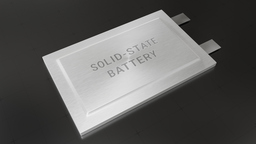Polymer Precursors for Coatings, Binder and Adhesive Applications for Solid State Electrolytes
TECHNOLOGY NUMBER: 2019-033

OVERVIEW
An improved method for incorporating LiPON materials onto solid state batteries- An approach that is amenable to dip coating to substrates of interest
- A resulting product with improved ionic conductivities
BACKGROUND
Short-circuits in batteries cause rapidly release all of stored energy and can cause heat release that is capable of igniting the flammable components within lithium ion batteries. One of the leading causes of short-circuits in lithium ion batteries is the uneven deposition of lithium ions on the anode, which can eventually bridge the anode to cathode. In an effort to address this issue, battery researchers have sought solid-state electrolytes that provide a physical barrier to dendrite formation. An attractive material for these applications is lithium phosphorous oxynitride (LiPON), a rigid ceramic material that resists dendrite penetration while providing lithium conductivity. Limitations to LiPON materials as solid-state electrolytes include the requirement for expensive manufacturing equipment which limits production scalability. Furthermore, LiPON has poor ionic conductivity compared to anode and cathode materials, minimizing the number of useful battery applications. So, a need exists for improved methods to build LiPON solid-state electrolytes to overcome current limitations.
INNOVATION
Researchers have devised a method for producing solubilized phosphorous oxynitride (PON), lithium phosphorous oxynitride (LiPON), and silicon containing LiPON (LiSiPON) in a polymeric or oligometic state that is amenable to dip coating application to substrates of interest. Using this approach, phosphorous oxychloride is first treated with NaNH2 to generate the PON precursor which is subsequently lithiated using LiNH2 at a 90% molar equivalence to the sodium amide from the previous step. The resulting material can be found to have a uniform deposition of LiPON with significantly improved ionic conductivities compared to conductivities observed for vapor deposited films. The ability to coat substrates of interest via dip coating offers a significantly more economical and readily scaled methodology for incorporating LiPON materials into solid-state batteries. These materials and this process can be utilized to employ LiPON as a binder, protective coating, or adhesive for the construction of solid-state batteries.
PATENT APPLICATION
Number:US20210340011
-
expand_more mode_edit Inventor (3)Eleni TemecheRichard LaineXinyu Zhang
-
expand_more library_books References (4)
- Zhang X, Temeche E, and Laine RM. , Synthesis, and Characterization of Polymer Precursors to LixPON and LixSiPON Glasses: Materials That Enable All-Solid-State Batteries (ASBs). Macromolecules 2020 53(7), 2702-2712 https://doi.org/10.1021/acs.macromol.0c00254
- Temeche E, Zhang X, and Laine RM. , Precursor Derived LixPON Electrolytes: Toward Li-S Batteries. ACS Applied Materials & Interfaces 2020 12(18), 20548-20562. https://doi.org/10.1021/acsami.0c03341
- Temeche E, Zhang X, and Laine RM. , Electrolytes for Li-S Batteries: Solid Solutions of Poly(ethylene oxide) with LixPON- and LixSiPON-Based Polymers. ACS Applied Materials & Interfaces 2020 12(27), 30353-30364 https://doi.org/10.1021/acsami.0c06196
- Temeche E, Buch E, Zhang X, Brandt T, Hintennach A, and Laine RM. , Electrochemical Properties of Li4Ti5O12 Nanopowders (NPs) via Addition of LiAlO2 and Li6SiON Polymer Electrolytes, Derived from Agricultural Waste, ACS Applied Energy Materials 2021 4(2), 1894-1905. https://doi.org/10.1021/acsaem.0c02994
-
expand_more cloud_download Supporting documents (1)Product brochurePolymer Precursors for Coatings, Binder and Adhesive Applications for Solid State Electrolytes.pdf